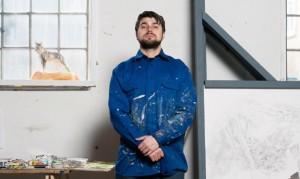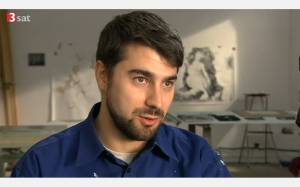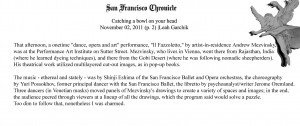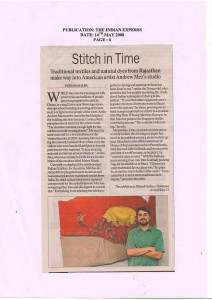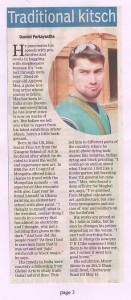November 1, 2011
In
Press
A Great Dance Event Missed by Most by Janos Gereben
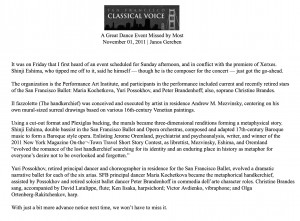 It was on Friday that I first heard of an event scheduled for Sunday afternoon, and in conflict with the premiere of Xerxes. Shinji Eshima, who tipped me off to it, said he himself ó though he is the composer for the concert ó just got the go-ahead.
It was on Friday that I first heard of an event scheduled for Sunday afternoon, and in conflict with the premiere of Xerxes. Shinji Eshima, who tipped me off to it, said he himself ó though he is the composer for the concert ó just got the go-ahead.
The organization is the Performance Art Institute, and participants in the performance included current and recently retired stars of the San Francisco Ballet: Maria Kochetkova, Yuri Possokhov, and Peter Brandenhoff; also, soprano Christine Brandes.
Il fazzoletto (The handkerchief) was conceived and executed by artist in residence Andrew M. Mezvinsky, centering on his own mural-sized surreal drawings based on various 16th-century Venetian paintings.
Using a cut-out format and Plexiglas backing, the murals became three-dimensional renditions forming a metaphysical story. Shinji Eshima, double bassist in the San Francisco Ballet and Opera orchestras, composed and adapted 17th-century Baroque music to form a Baroque style opera. Enlisting Jerome Oremland, psychiatrist and psychoanalysis, writer, and winner of the 2011 New York Magazine On-the¨-Town Travel Short Story Contest, as librettist, Mezvinsky, Eshima, and Oremland ìevolved the romance of the lost handkerchief searching for its identity and an enduring place in history as metaphor for everyoneís desire not to be overlooked and forgotten.
Yuri Possokhov, retired principal dancer and choreographer in residence for the San Francisco Ballet, evolved a dramatic narrative ballet for each of the six arias. SFB principal dancer Maria Kochetkova became the metaphorical handkerchief, assisted by Possokhov and retired soloist ballet dancer Peter Brandenhoff in commedia dellíarte character roles. Christine Brandes sang, accompanied by David Latulippe, flute; Ken Iisaka, harpsichord; Victor Avdienko, vibraphone; and Olga Ortenberg-Rakitchenkov, harp.
With just a bit more advance notice next time, we wonít have to miss it.
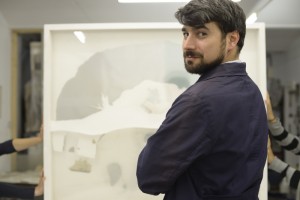 Im November startet die Ausstellung des amerikanischen Künstlers Andrew M. Mezvinsky im Jüdischen Museum. wina traf ihn zu einem Gespräch in seinem Studio in Wien.
Im November startet die Ausstellung des amerikanischen Künstlers Andrew M. Mezvinsky im Jüdischen Museum. wina traf ihn zu einem Gespräch in seinem Studio in Wien.
